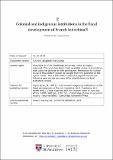Files in this item
Colonial and indigenous institutions in the fiscal development of French Indochina
Item metadata
| dc.contributor.author | López Jerez, Montserrat | |
| dc.contributor.editor | Frankema, Ewout | |
| dc.contributor.editor | Booth, Anne | |
| dc.date.accessioned | 2020-05-12T23:34:43Z | |
| dc.date.available | 2020-05-12T23:34:43Z | |
| dc.date.issued | 2019-11-13 | |
| dc.identifier | 260822435 | |
| dc.identifier | 50ebbe6c-e9b3-40a1-8d2d-2445db58ea6a | |
| dc.identifier | 85097687165 | |
| dc.identifier.citation | López Jerez , M 2019 , Colonial and indigenous institutions in the fiscal development of French Indochina . in E Frankema & A Booth (eds) , Fiscal capacity and the colonial state in Asia and Africa, c. 1850-1960 . Cambridge studies in economic history - second series , Cambridge University Press , Cambridge , pp. 110-136 . https://doi.org/10.1017/9781108665001.004 | en |
| dc.identifier.isbn | 9781108494267 | |
| dc.identifier.isbn | 9781108665001 | |
| dc.identifier.other | ORCID: /0000-0001-7988-9049/work/65014442 | |
| dc.identifier.uri | https://hdl.handle.net/10023/19926 | |
| dc.description.abstract | Official revenue collections in French Indochina were low compared with most other colonies in East and Southeast Asia. This fact stands in contrast to a large body of literature that claims French tax demands were a crushing burden on many indigenous people. French Indochina is often put forward as an example of one of the most extractive colonial states in Asia. This chapter reconciles these seemingly opposing interpretations by examining the formation of the colonial fiscal state, its capacity, and the potential impact on the local population. We argue that the French colonial administration is best characterized as complex, bureaucratic, and centralized. Its fiscal capacity was heavily dependant on the expansion and growth of commercial activities. This led to significant geographical asymmetries in wealth generation and investments, and a complex system of budgetary transfers amongst the different levels of administration. French rule was, however, indirect and responded to local differences. Pre-colonial fiscal institutions survived under French colonial rule, but were not adequately recognised in the figures. This reinforces the claim that the burden to the majority of the population was greater than officially recorded, but it was unevenly distributed. | |
| dc.format.extent | 1149461 | |
| dc.language.iso | eng | |
| dc.publisher | Cambridge University Press | |
| dc.relation.ispartof | Fiscal capacity and the colonial state in Asia and Africa, c. 1850-1960 | en |
| dc.relation.ispartofseries | Cambridge studies in economic history - second series | en |
| dc.subject | DC France | en |
| dc.subject | DS Asia | en |
| dc.subject | HC Economic History and Conditions | en |
| dc.subject | BDC | en |
| dc.subject | R2C | en |
| dc.subject.lcc | DC | en |
| dc.subject.lcc | DS | en |
| dc.subject.lcc | HC | en |
| dc.title | Colonial and indigenous institutions in the fiscal development of French Indochina | en |
| dc.type | Book item | en |
| dc.contributor.institution | University of St Andrews. School of History | en |
| dc.identifier.doi | 10.1017/9781108665001.004 | |
| dc.date.embargoedUntil | 2020-05-13 | |
| dc.identifier.url | https://doi.org/10.1017/9781108665001 | en |
This item appears in the following Collection(s)
Items in the St Andrews Research Repository are protected by copyright, with all rights reserved, unless otherwise indicated.

